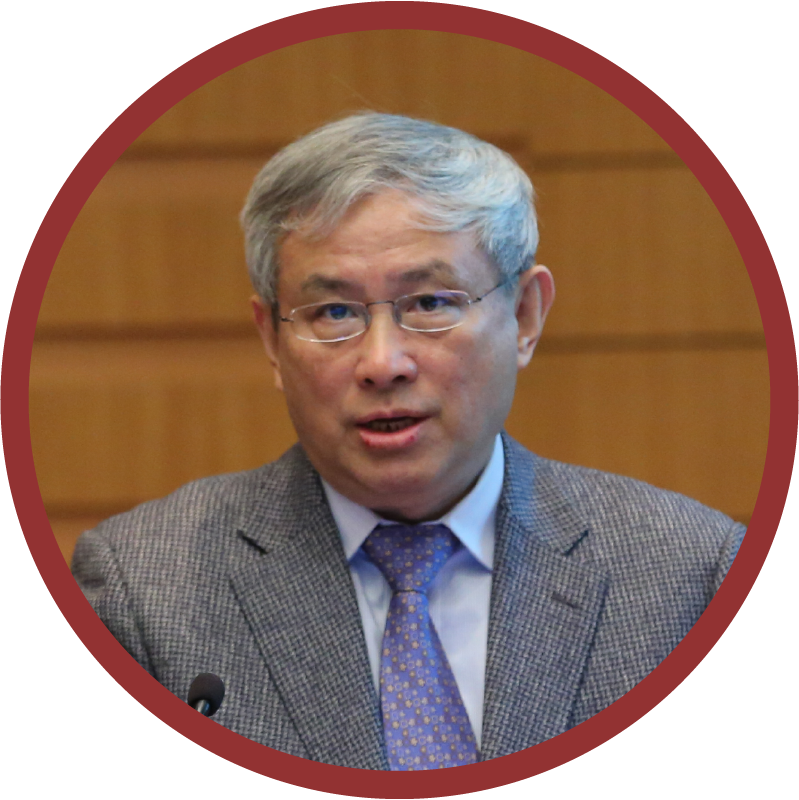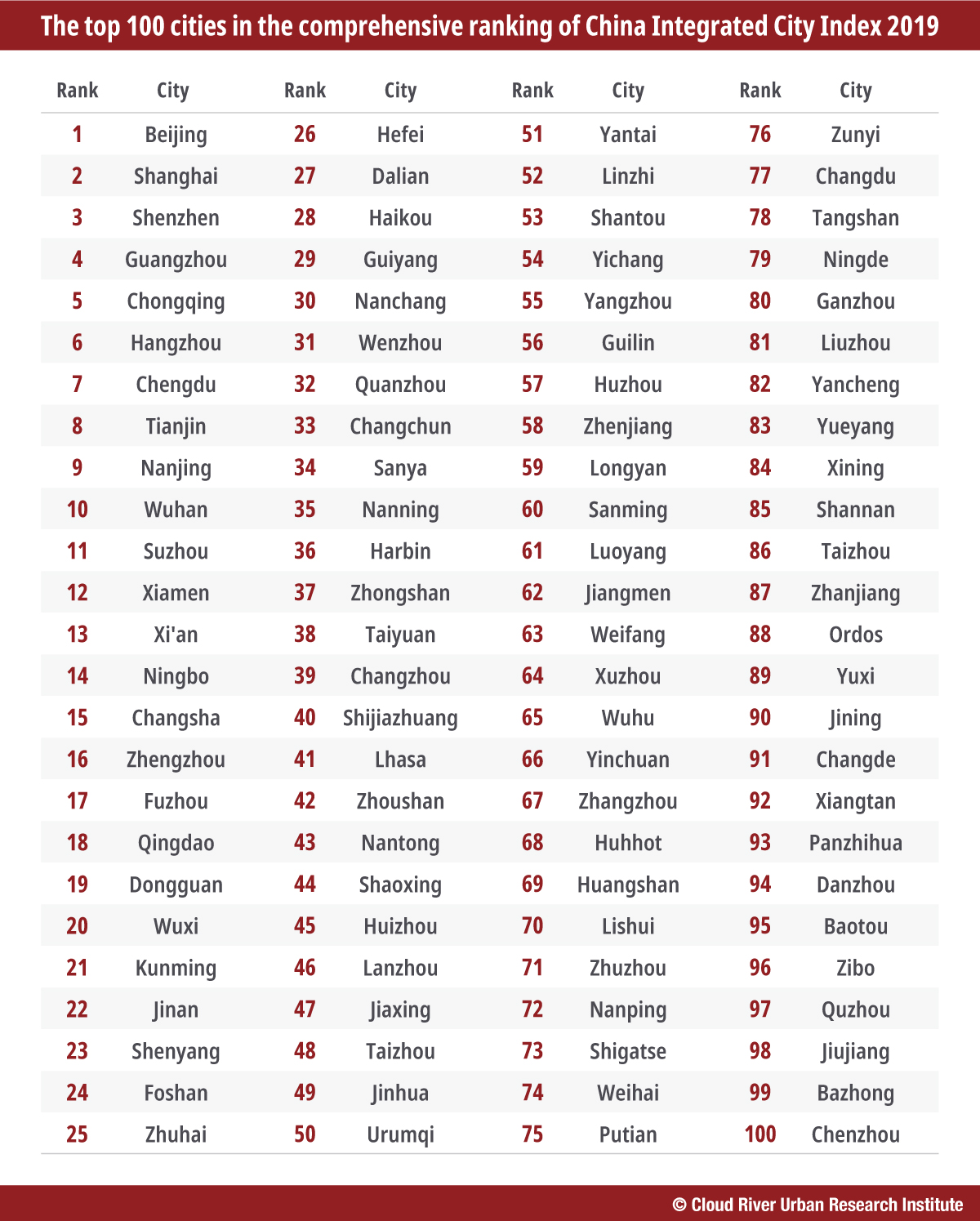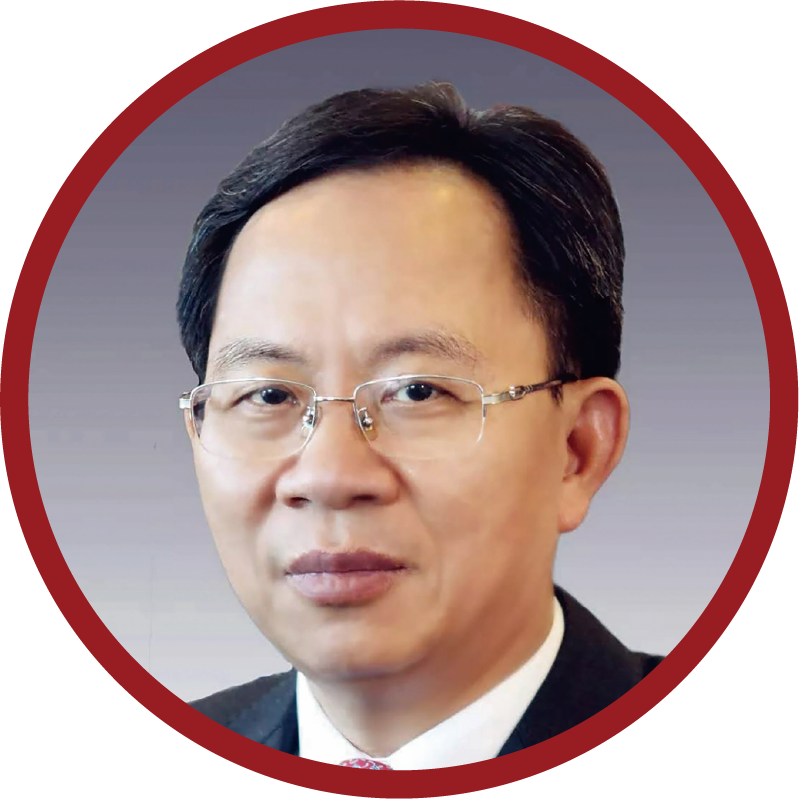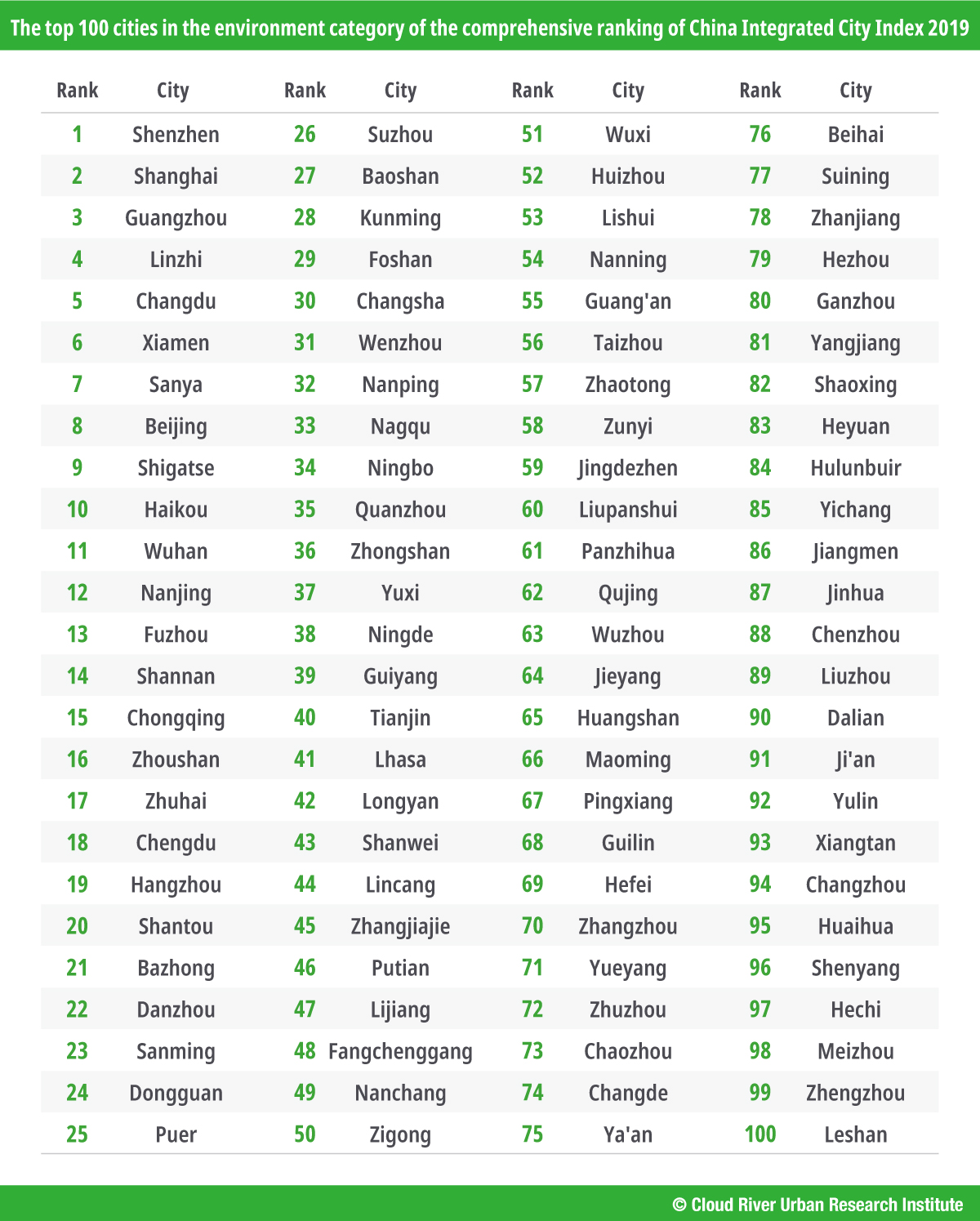In the beginning of this year, Cloud River Urban Research Institute released the China Integrated City Index 2019, which ranks 297 Chinese cities at the prefecture level and above based on a comprehensive evaluation, as well as the top 100 cities in the categories of the environment, society and economy.
In the beginning of this year, Cloud River Urban Research Institute released the China Integrated City Index 2019, which ranks 297 Chinese cities at the prefecture level and above based on a comprehensive evaluation, as well as the top 100 cities in the categories of the environment, society and economy. Renowned scholars such as Zhao Qizheng, Yang Weimin, Zhou Qiren, Qiu Xiaohua, Du Ping, and Ming Xiaodong all have given a positive feedback on the Index in their articles, as well as their outlook on and expectations of the future development of Chinese cities.

Zhao Qizheng
dean of the School of Journalism at the Renmin University of China, and former minister of the State Council Information Office of China
I think the Index provides a new concept, a new discourse and a new framework for understanding and managing cities. I believe this book is a helpful reference book for Chinese mayors and their assistants. In the 1990s, when I was vice mayor of Shanghai, and the director and Party secretary of Pudong New Area, I was responsible for the development and construction of the new area. It was a pity that we didn’t have such a good reference book at that time.
Many indicators are needed to describe a man’s growth. A medical check-up entails dozens of indicators. Thirty years ago, we and even doctors had no idea of the health indicators that are common today. In such a case, how can we manage our body in a science-based way? Thirty years ago, Chinese people had an average life expectancy of less than 70 years. Now, the figure has approached 80, because health indicators have come into play.
In the same vein, we paid inadequate attention to what indicators can be used to describe the conditions of cities. We had outlined the plan of urban development by simply taking politics, economy, culture and other macro aspects into account. That was a very rough and crude approach. Now, if we need to plan and manage cities in an accurate way, we have to have a clear concept and research of cities, and delve into the analysis supported by a comprehensive index system. Therefore, Chinese cities can be built on the concept and the rational and comprehensive framework provided by the China Integrated City Index. A sophisticated data analysis and an in-depth research will come up with a recipe for “governance.” That is the call of the times.

Yang Weimin
member of the Standing Committee of the Chinese People’s Political Consultative Conference National Committee, and former deputy director of the office of the Central Leading Group for Financial and Economic Affairs of China
The Index, jointly developed by the Development Planning Department of the National Development and Reform Commission and the Cloud River Urban Research Institute, is the most scientific, international and practical index concerning the development of Chinese cities I have ever seen. It is a comprehensive “health check-up report” for Chinese cities. Every city evaluated by the Index can find its “diseases” and get a treatment plan. The “health check-up report,” released on an annual basis, will add more indicators, identify new situations and spot new problems.
Urbanization provides enduring impetus to China’s economic and social development, and China’s urbanization has a long way to go. At the same time, China’s economy has transformed to the phase of high-quality development. Urbanization and high-quality development are converged. Cities are main players in economic development, and also spatial carriers of high-quality development. China’s high-quality development as a whole hinges on high-quality development of Chinese cities.
The China Integrated City Index provides an evaluation of urban development from the environmental, social and economic perspectives, and embodies the idea of spatial balance. That is why I say it is a truly comprehensive and genuine evaluation of development. Only in this way will the evaluation of urban development be scientific and conducive to guiding the development of cities in a more comprehensive, coordinated and sustainable manner.
China’s urban development must adhere to the philosophy of ecological civilization, promote green development, circular development and low-carbon development, and minimize the interference with and damage to the nature, while promoting the economical and intensive utilization of resources including land, water and energy. Much attention should be paid to eco-safety, and the ratio of green and ecological spaces, such as forests, lakes and wetlands, should be increased, in order to enhance the water conservation capacity and environmental capacity. The quality of environment should be improved, by reducing emissions of major pollutants, controlling over the intensity of development, and increasing the capability to withstand and mitigate natural disasters. The China Integrated City Index provides a number of implementable green indicators. All cities should check for their gaps from the indicators and find out the areas to work on for urban development. In this regard, the China Integrated City Index is not only an evaluation, but also points out the direction for future development.

Zhou Qiren
professor of the National School of Development at Peking University
Competition among cities is a major driving force for elevating urban civilization. The areas that cities compete in are crucial as they determine the future and quality of urban development. History shows, the cities that have chosen the right path and target tend to enjoy sustainable and stronger competitiveness. In this sense, the China Integrated City Index, compiled by Professor Zhou Muzhi and his team, provides reliable statistical foundation for China’s high-quality urban development. It’s like vivid “City Portraits” from which citizens, visitors, entrepreneurs, businesses, investors and other stakeholders can find clues for their living, productions, operations, and business investment. Urban planners, decision-makers and constructors can also rely on this set of data to choose the right target for urban development and make effective urban competition strategies, thus laying a foundation for healthier urban development.
Chart: The top 100 cities in the comprehensive ranking of China Integrated City Index 2019


Qiu Xiaohua
vice chair of Cloud River Urban Research Institute, head of the Institute of Economic Research at City University of Macau, and former head of the National Bureau of Statistics
The China Integrated City Index is an important set of indicators, mainly in the following four ways.
First, it’s like a compass that gives the targets and shows the direction navigating future development of the cities.
Second, it’s like a yearbook recording the footprints and depicting major areas of the urban development, which provides various information for officials, scholars and stakeholders of different sectors as they manage or study urban development.
Third, it’s like a “diagnosis” reflecting the conditions of cities’ development within a period of time to help with urban management and urban research.
Fourth, it’s also a report card summarizing achievements in urban development from the statistical perspective. It also offers a sneak peek of the performance of 297 cities over a year.
The China Integrated City Index 2019 has been released. It is an annual review as well as a “physical check” for major cities in China. From the Index, we can see both achievements and setbacks in China’s urban development. The achievements manifest China’s progress in building a moderately prosperous society in all respects, and the setbacks reflect that there are areas we need to pay more attention to in our modernization process. Looking into the future, we need to do an even better job in our strong areas and address the setbacks more efficiently. We expect stable and long-term development as we achieve China’s second centenary goal and create more harmonious relations with the rest of the world.

Du Ping
vice chairman of Cloud River Urban Research Institute, and former vice executive director of the State Information Center
With available English and Japanese versions, the China Integrated City Index is a major set of indicators that have a global influence and provides food for thought for local governments, the academia, businesses and stakeholders in various sectors.
I want to say that the China Integrated City Index has its unique features.
First, it guarantees data integrity and accuracy. China Integrated City Index has pioneered a data collection and processing system sourcing from three major areas, with around 30% coming from statistical data, 30% from satellite remote sensing data, and 40% from internet data. The system can acquire sufficient and accurate data timely to support the validity of the Index’s structure.
Second, the Index is based on available, comparable and regressable data. The China Integrated City Index is a 3*3*3 multi-modal index system with closely related but independent data sets. In Chinese culture, our planet is a huge system composed of the heaven, earth, humanity and all other living creatures. China’s ancient philosopher used the idea of “One produced Two; Two produced Three; and Three produced All Things” to generalize the changes of this huge system in an abstract way. Obviously, the 3*3*3 framework agrees with this philosophy. Seen from its design concept, the logic relations between the indicators and the whole framework, the China Integrated City Index aims to reveal the relevance between each dimensions and sub-dimensions within a city as well as between different cities. To put it simply, the Index measures urban development on the top level in three dimensions: environment, society and economy, under which there are 9 sub-dimensions on the second layer followed by another 27 smaller dimensions on the third layer, all supported by a total of 878 data sets. Therefore, the China Integrated City Index can not only measure the development trends of each city from a macro level, but also evaluate the changes in different dimensions and areas of a city, as well as the changes in urban structures. I believe it is valuable in navigating high-quality and sustainable urban development.
Third, the Index has created a set of new indicators to mirror the cities’ development trends. For example, we can see the scope as well as the quality of urban development from the DID Population indicator; and you can also analyze the relations between industrial development and urban functions from the manufacturing radiation, IT industry radiation as well as indicators like opening and communications.
Fourth, the Index includes the comparison between Chinese cities and their international counterparts. For example, the China Integrated City Index compared major indicators between Beijing and Tokyo metropolitan areas after the 21st Century and effectively and objectively pointed out the problems and future development of China’s metropolitan areas.
In conclusion, the China Integrated City Index is a forward-looking and strategic index system that can help navigate China’s high-quality urban development.

Ming Xiaodong
official of the National Development and Reform Commission, and former minister-counsellor of the Chinese Embassy in Japan
The China Integrated City Index 2019 jointly compiled by the National Development and Reform Commission and Cloud River Urban Research Institute was released. It is the fourth one since its launch in 2016. In view of historical data, the Index accurately documents China’s urban development, and reflects the improvement in the quality of China’s urban development, the spatial forms, as well as the urban-rural structure.
From the perspective of the quality of development, the Index scores the ability and scale of the sustainable development of cities on indexes of the environment, society, and economy, encompassing 878 sets of data. In view With an eye to the new round of the scientific and technological revolution and the industrial revolution, the Index has selected a series of indictors related to innovation and entrepreneurship to reflect the new vitality of urban development. Since the Index was unveiled for the first time five years ago, the quality of China’s urban development and the urbanization rate have been significantly improved. A rural migrant population of about 100 million has settled down in cities, and more than 13 million new jobs were created in cities each year. The urban rail transit has developed rapidly, with operating mileage exceeding 5,500 kilometers. Cities have enhanced their governance ability, as the sewage treatment rate reached 95.6%, and the harmless treatment rate of domestic waste remarkably increased. Cities have taken a new look while scoring substantial progress in building a green, smart and cultural city.
From the perspective of spatial forms, the Index looks at 297 cities at prefecture-level and above across the country, which makes the Index broad-based and representative and reflects the characteristics of China’s spatial and economic layout in cities. Many of these cities are national central cities or regional central cities, featuring city clusters as the main body of China’s urban spatial layout. The Index includes a series of sub-indexes regarding core radiation to represent a city’s influence in a certain field. Over the past five years, the effect of China’s urban population clustering and economy have taken effect, as 19 cities accommodate more than 75% of urban population and contribute over 80% of GDP. The formation of metropolitan areas speeds up. With central cities playing a bigger role, infrastructure, public services and industrial development are further integrated. The number of cities increased from 657 to 684.
From the perspective of the urban-rural structure, although the Index takes cities as the main object to give a comprehensive evaluation of urban development, agriculture-related sub-indicators in the categories of the environment, society and economy have been designed in view of the “cities manage villages” situation in China’s administrative regions. In particular, combining the reality of “uneven urban-rural development is the prominent problem in China’s economic and social development,” the major indicator of economy encompasses a series of sub-indicators concerning urban-rural integration, and reflects interaction between urban development and rural vitalization. Over the past five years, China’s integration between urban and rural development has made headway. With better urban-rural development integration mechanism and policies, we have aligned urban basic public service system with its rural counterpart at an accelerated speed. Rural infrastructure such as water, electricity, roads and the network has been enhanced across the board, and urban-rural income ratio dropped from 2.75 in 2014 to 2.64 in 2019.
The Index represents some new changes in China’s urban development. Compared with the previous year, cities have further polarized as seen in the ranking. Changchun and Harbin in northeastern China no longer made the top 30, largely due to a steep decline on the social indicator. Nanchang in central China and Guiyang in western China made their way into the top 30. In terms of the environment, the ranking changes greatly. Shanghai and Guangzhou moved up to second and third spots after Shenzhen, indicating that the environment of mega cities can be significantly improved as long as their management level are enhanced. Wenzhou, Longyan, Heihe, Tianjin, Nanping, Putian, Quanzhou, Hulun Buir, Lincang dropped out the top 30. Measured by the social indicator, cities’ ranking correlates with the economic ranking, indicating economic growth is the backbone of social development. Shijiazhuang and Taiyuan fell out of the top 30. Measured by the economic indicator, the ranking changes slightly, but the top league is still dominated by those traditionally powerful cities, with Changzhou and Yantai dropping out the top 30. Changes in indicators show that China’s economy is overall balanced, but its economic focus remained in the south. The ecological environment has improved, but several cities that are long famed for their good environment slipped in the ranking. Social development has made progress, but still relies heavily on economy.
To sum up, the Index is based on scientific selection and a complete system, covering major dimensions of urban development. It represents the future development of cities, and can serve as a good reference book for the comprehensive assessment of cities.
Chart: The 101st to 200th cities in the comprehensive ranking of China Integrated City Index 2019

Chart: The 201st to 297th cities in the comprehensive ranking of China Integrated City Index 2019

Chart: The top 100 cities in the environment category of the comprehensive ranking of China Integrated City Index 2019

Chart: The top 100 cities in the social category of the comprehensive ranking of China Integrated City Index 2019

Chart: The top 100 cities in the economic category of the comprehensive ranking of China Integrated City Index 2019

The article was published on China SCIO Online on Mar 3, 2021, and was republished by foreign media, including China Daily, China net, as well as today’s headlines and other platforms.

